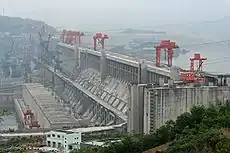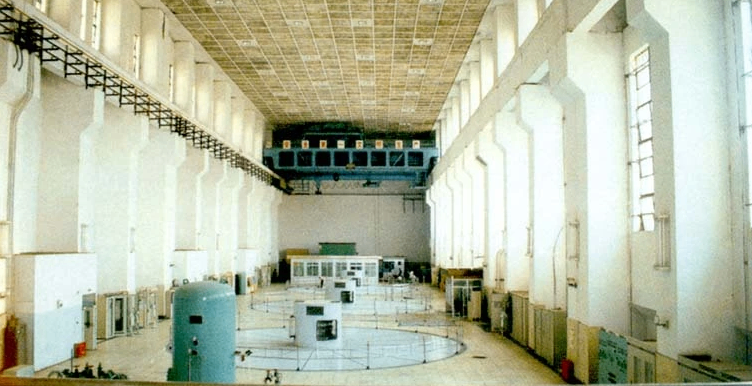We will present the performance, safe operation methods, and technical parameters of 水力発電
簡単な紹介
水力発電は、河川、湖、その他の河川、湖のポテンシャルエネルギーを利用して、それに含まれるポテンシャルエネルギーをタービンの運動エネルギーに変換し、水力タービンを駆動力として発電機を促進して電力を発電します。水力タービンに別の機械 ( 発電機 ) を接続すると、水力タービンが回転するにつれて電力を発電し、機械エネルギーを電気エネルギーに変換することができます。ある意味、水力発電は水のポテンシャルエネルギーを機械エネルギーに変換し、電気エネルギーに変換するプロセスです。水力発電所から放出される電力電圧が低いため、長距離のユーザーに伝送するためには、変圧器を通じて電圧を増加させ、空のラック送電線によってユーザー集中地域の変電所に輸送し、最終的に家庭のユーザーや工場の電力機器に適した電圧に低減し、配電線によって各工場や家庭に送信する必要があります。
原理
How does 水力発電 work? The whole プロセス of animation shows the whole プロセス, and years of doubts are solved
The basic 原理 of 水力発電 generation is to use the water level drop to 電気を生成する with the hydro turbine generator, that is, to use the potential energy of water to convert into the mechanical energy of the water turbine, and then use the mechanical energy to push the generator to obtain electricity. Scientists have used the natural conditions of the water level drop to effectively use fluid engineering and mechanical physics to achieve the highest power generation and provide people with cheap and pollution-free electricity.
一方、低レベルの水は太陽光を吸収することで地球全体に分布し、それによって高レベルの水源を回復します。
In 1882, the first recorded application of hydroelectric power was in Wisconsin, USA. Today, the scale of 水力発電 generation ranges from tens of watts used in the countryside of the third world to millions of watts for power supply in large cities.

クラス
According to the クラスification of concentrated drops, there are: embankment 水力発電 plants, diversion 水力発電 plants, hybrid 水力発電 plants, tidal 水力発電 plants and pumped storage power plants.
According to the degree of runoff regulation, there are: unregulated 水力発電 plants and regulated 水力発電 plants.
According to the nature of water sources, it is generally called conventional 水力発電 stations, that is, using natural rivers, lakes and other water sources to 電気を生成する.
According to the size of the water head used by the 水力発電 station, it can be divided into high head (more than 70 meters), medium head (15-70 meters) and low head (less than 15 meters) 水力発電 stations.
According to the installed capacity of 水力発電 stations, they can be divided into large, medium and small 水力発電 stations. Generally, the installed capacity of less than 5,000kW is called small 水力発電 stations, those with an installed capacity of 5,000 to 100,000kW are called medium-sized 水力発電 stations, and those with an installed capacity of 100,000kW or more are called large 水力発電 stations or giant 水力発電 stations.
プロセス
When the unit needs to run to 電気を生成する, open the main valve (similar to the function of the faucet at home), and then open the guide wing (a small water gate that actually controls the output force) to make the water impact the turbine. If you want to adjust the output of the generator set, you can adjust the opening of the guide wing to increase or decrease the amount of water to achieve it, and the water after power generation returns to the river through the tail channel to supply the downstream water.
利点
水
ハイドロエネルギーは无尽蔵、无尽蔵、再生可能なクリーンエネルギー源です。ただし、自然の水エネルギーを効果的に使用するには、ダム、迂回管、暗渠など、水滴を集中させて流れを調整できる油圧式の建物を手動で建設する必要があります。したがって、プロジェクトの投資は大きく、建設期間は長いです。ただし、水力発電は効率が高く、発電コストが低く、ユニットの始動が速く、調整が簡単です。自然の水の流れを使用するため、自然条件の影響を大きく受けます。水力発電は、多くの場合、水資源の包括的な利用の重要な部分であり、海運、水産養殖、灌漑、洪水制御、観光とともに、包括的な水資源利用システムを形成します。
電気を生成する
水力発電は、環境への影響が少ない再生可能エネルギー源です。安価な電力を提供することに加えて、洪水調節、灌漑用水、河川航行の改善、地域の輸送、電力供給、経済、特に観光と水産養殖の改善という利点もあります。米国のテネシー川の包括的な開発計画は、全体的な経済発展を推進する最初の大規模な水利プロジェクトです。

欠点
一般的な概要
1. Due to terrain limitations, it is not possible to build too large capacity. The capacity of the unit is about 300MW.
2. The construction period of the factory is long and the construction cost is high.
3. Because it is located in natural rivers or lakes, it is susceptible to feng shui disasters, affecting other water conservancy undertakings. Power output is susceptible to weather drought and rain.
4. It is not easy to increase capacity after the factory is built.
5. Ecological damage: intensified erosion of water flow below the dam, changes in rivers and their impact on animals and plants, etc.
6. Damming is needed to immigrate, etc., and the investment in infrastructure construction is large.
7. The fertile alluvial soil downstream is reduced by erosion.
生態学的影響
Huge dams that flood a wide range of upstream areas can destroy biodiversity, productive lowlands, river valley forests, wetlands and grasslands, and reservoirs built for 水力発電 can cause fragmentation of habitats in surrounding areas and worsen soil erosion.
水力発電プロジェクトは、周辺地域の上流と下流の水生生態系に影響を及ぼします。たとえば、北米の大西洋岸と太平洋岸に沿ったダムは、ダムが繁殖地でこれらの魚が上流で産卵するのを防ぐため、上流で産卵する必要のあるサケの個体数を減らすことが研究によって示されています。魚のはしごはサケの生息地で最大のダムに設置されていますが、これは避けられません。若い鮭も、海に移動するときに発電所のタービンを通過しなければならないため、被害を受けています。これらの魚を保護するために、米国の一部の地域では、年間を通じて小さなサケをヨットで下流に輸送しています。例外的に、マーモットダムなどの一部のダムは、魚への影響により撤去されました。水生生物へのダメージが少ないタービン発電機を設計する方法は、研究の活発な分野です。魚のはしごなどのいくつかの緩和策は、一部の国で新しいプロジェクトの承認と既存のプロジェクトのレビューの要件になっています。
たとえば、揚子江流域での大規模な水利プロジェクトの建設は、チョウザメの移動ルートと繁殖地に深刻な影響を及ぼし、その個体数を急激に減少させ、絶滅の危機に瀕しています。
環境への影響
水力発電の環境への影響水力発電の環境への影響水力発電の環境への影響
1. Geography: Huge reservoirs may cause surface activity and even induce earthquakes. In addition, it will also cause hydrological changes in the basin, such as a decrease in the downstream water level or a decrease in sediment from the upstream. After the completion of the reservoir, due to the large evaporation, the climate is cool and stable, and the rainfall is reduced.
2. Biological aspects: For terrestrial animals, after the completion of the reservoir, a large number of wild animals and plants may be submerged and killed, or even completely extinct. For aquatic animals, after the completion of the reservoir, due to changes in the upstream ecological environment, fish will be affected, resulting in extinction or population reduction.
At the same time, due to the expansion of the upstream water area, the habitat of certain organisms (such as snails) has increased, creating conditions for the spread of some regional diseases such as schistosomiasis.
3. Physical and chemical properties: The water flowing into and out of the reservoir changes in terms of physical and chemical properties such as color and odor, and the density, temperature, and even solubility of each layer of water in the reservoir are different. The water temperature of deep water is low, and the organic matter at the bottom of the sedimentary reservoir cannot be fully oxidized in anaerobic decomposition, and the carbon dioxide content of the water body increases significantly.
分類
According to the nature of water sources, they can be divided into: conventional 水力発電 stations, that is, using natural rivers, lakes and other water sources to 電気を生成する.
揚水発電所は、電力網負荷のトラフで余剰電力を使用して、下部の貯水池から高い場所に水を汲み上げて貯蔵し、グリッドの負荷がピークに達したときに水を放出して発電し、下部の貯水池のテール水。
According to the means of developing water heads of 水力発電 stations, it can be divided into:
There are three basic types: dam 水力発電 station, diversion 水力発電 station and hybrid 水力発電 station.
According to the size of the water head used by the 水力発電 station, it can be divided into:
High head (above 70 meters), medium head (15-70 meters) and low head (less than 15 meters) 水力発電 station.
According to the size of the installed capacity of 水力発電 stations, it can be divided into:
Large, medium and small 水力発電 stations. Generally, small 水力発電 stations with an installed capacity of less than 5 000 kW, medium-sized 水力発電 stations with 5 000 to 100,000 kW or more, and large 水力発電 stations with a capacity of 100,000 kW or more are large or mega 水力発電 stations.
進化
1878 年、フランスは世界初の水力発電所を建設した。アメリカ大陸で最初の水力発電所は、 1882 年 9 月 30 日に水車で駆動される 2 台の DC 発電機で構成され、 25 kW の設備容量で建設された。ヨーロッパ初の商業用水力発電所は 1885 年に建設されたイタリアのテヴォリ水力発電所であり、設備容量は 65 kW であった。19 世紀 90 年代以降、北米や欧州の多くの国で水力発電が評価され、山岳地帯の乱流川や落水、滝などの優れた地形を利用して数万から数千キロワットの水力発電所が建設されている。1895 年、米国のナイアガラの滝に 3750 kW の大型タービン駆動水力発電所が建設された。カナダの国境。20 世紀に入ると、長距離送電技術の発展により、遠隔地の水力資源が徐々に開発 · 利用され、都市や電力センターに電力を供給するようになりました。30 年代以降、水力発電の建設のスピードと規模はますます急速に発展し、ダム建設、機械、電気などの科学技術の進歩により、非常に複雑な自然条件下でさまざまな種類と規模の水力発電プロジェクトを建設することが可能になりました。世界の利用可能な水力発電資源は約 22 億 6100 万 kW で、不均等に分布しており、開発の程度は国によって異なる。
中国は世界で最も豊富な水力資源を持つ国であり、開発可能な容量は約3億7800万kWです。中国本土で最初の水力発電所は、雲南省のマンティス川に建設されたシロンバ水力発電所 (カラーマップを参照) で、1910年7月に建設され、1912年に発電され、当時の設備容量は480kWでした。段階的に再建および拡張され、最終的には6000kWに達しました。1949年に中華人民共和国が設立される前は、全国に42の水力発電所が建設および部分的に建設され、総設備容量は36万kWで、年間発電量は12億kW・h (台湾を除く) でした。1950年以降、水力発電の建設は大きく発展し、設備容量が250,000 kWを超え、中型で25,000〜250,000 kW、小型で25,000kW未満の単一の水力発電所がありました。それらの最大のものは揚子江の長江三峡です。いくつかの川には多数の中型水力発電所が建設されており、そのうちのいくつかはカスケードとして直列に接続されています。さらに、いくつかの中小規模の川や溝に多数の小さな水力発電所が建設されています。1987年末までに、中国の水力発電の設備容量は3,019万kW (500kW未満の小型水力発電所を除く) であり、小型水力発電所の総設備容量は1,110万kW (500kW未満の小型水力発電所を含む。小水力を参照)。2010年8月25日、雲南省で最大の単一投資プロジェクトである華能暁湾水力発電所4号機 (設備容量70万キロワット) が正式に発電に向けて稼働し、2億以上の設備容量を持つ画期的なユニットになりました。中国では百万キロワット、そして私たちの国の水力発電の総設備容量は世界で最初の場所に跳ね上がりました。
中国は世界で最も水資源が豊富な国の1つであり、開発可能な設備容量は5億4200万キロワットの水力エネルギー資源、経済的に開発された設備容量は4億200万キロワットであり、開発の可能性は依然として非常に大きい。
見通し
水力資源が豊富で開発が少ない一部の国 (中国を含む) では、将来的には地域の状況に応じて水力の開発が優先されます。水力資源の開発度が高い国や水力資源が乏しい国や地域では、既存の水力発電所の拡張と変革、および原子力発電所の建設に関連して建設された揚水発電所の数が不可欠です。増加します。中国の大規模バックボーン発電所の建設に焦点を当てることに加えて、中小水力発電所は、その短い建設期間、迅速な効果、および環境への影響の少ないため、さらに注目を集めるでしょう。電力価格システムの改革により、水力発電の経済的利益をより適切に反映および評価することができ、投資を吸収し、水力発電の建設を加速するのに役立ちます。水力発電建設の予備作業では、リモートセンシング、テレメトリ、地球物理学的探査、コンピューター、コンピューター支援設計などの新しい調査技術が開発され、普及します。洪水、堆積物、貯水池の移動、環境保護、その他の問題は、より適切に処理されます。水力発電所の自動化と動員もさらに改善され、促進されます。長距離、超高電圧の開発、超伝導材料やその他の送電技術は、中国西部の豊富な水力資源の開発を加速し、東部沿岸地域に電力を送電するのに役立ちます。
With the implementation of the national "energy conservation and emission reduction" policy, energy substitution emission reduction has become China's practical choice, 水力発電 has become the first choice for renewable energy, and 水力発電 enterprises with cost 利点s at this stage will enter the fast lane of rapid development. Therefore, domestic excellent 水力発電 companies pay more and more attention to the research of the industrial market, especially the in-depth study of the industry development environment and industrial buyers. Because of this, a large number of excellent domestic 水力発電 companies have risen rapidly and gradually become leaders in China's 水力発電 industry!
The former world's largest hydroelectric turbine rotor was プロセスed in the Three Gorges Dam area and loaded and shipped to the Jinsha River Xiangjiaba Hydropower Station. So far, the Three Gorges Dam area has the ability to プロセス the world's largest 水力発電 unit rotors.
Xiangjiaba Hydropower Station, located in the lower reaches of the Jinsha River, is the fourth largest power station in the world, with a single unit capacity of 812,000 kilowatts, surpassing the Three Gorges to become the world's largest 水力発電 unit. The runner that started yesterday, with a maximum diameter of 10.5 meters, a height of 4.7 meters and a weight of 406 tons, is the core component of Unit 3 of Xiangjiaba Power Station, and its size, weight, technical content and manufacturing difficulty are the largest in the world today.
2012年、世界の水力発電は過去の平均を上回る4.3% 増加し、すべての純成長は中国からのものであり、世界の水力発電の年間純成長の100% を占め、単一の国で最大の年間増加の記録を打ち立てました。データシートで。国内統計によると、2012年には、中国の水力発電の新しい設備容量は1551万キロワットでした。2012年末までに、水力発電の設備容量は2億4,890万キロワット (揚水発電量2,031万キロワットを含む) に達し、国の設備容量の21.7% を占め、水力発電容量は8,641億kWhで29.3% 増加しました。前年比、国の発電量の17.4% を占め、前年比3.2ポイント増加し、2012年の水力発電設備の平均利用時間は6,000キロワット以上で3,555時間で、前年比536時間増加した。
In 2012, China's 水力発電 consumption reached 194.8 million tons of oil equivalent, an increase of 22.8 from the previous year (2011) of 158.2 million tons of oil equivalent; In 2012, China's 水力発電 consumption was 194.8 million tons of oil equivalent, accounting for 23.4% of the global 水力発電 consumption of 831.1 million tons of oil equivalent, making it the world's largest producer/consumer of 水力発電 and the second largest producer/consumer of 水力発電. 206 of the consumption (94.5 million tonnes of oil equivalent).
テクノロジー
水エネルギーの電気への変換のエンジニアリング建設、生産、運用の科学技術に関する研究。水力発電で使用される水エネルギーは、主に水域に蓄えられた位置エネルギーです。水を電気に変換するには、さまざまな種類の水力発電所を建設する必要があります。これは、一連の建物と設備からなるエンジニアリング手段です。建物は主に、自然の水流の滴を集中させ、水頭を形成し、貯水池を使用して自然の水流の流れを収集および調整するために使用されます。基本的な装置はハイドロタービン発電機セットです。水流が水力発電所の迂回棟を通ってタービンに入ると、タービンは水流によって回転するように駆動され、水エネルギーは機械的エネルギーに変換されます。水タービンは発電機を駆動して発電し、機械的エネルギーは電気エネルギーに変換され、変電所と送電および配電装置を介してユーザーに送信されます。水エネルギーは自然界で再生可能なエネルギー源であり、水循環で繰り返し再生されます。水エネルギーと化石燃料はどちらも資源の一次エネルギー源であり、電気エネルギーに変換されると二次エネルギー源と呼ばれます。水力建设は、稼働中に燃料を消费することなく、一次エネルギー开発と二次エネルギー生产を同时に完了する电力建设であり、稼働管理料や発电コストは石炭火力発电よりもはるかに低い。水力発電は、水のエネルギーを電気に変換する過程で化学変化を受けず、有害物質を排出せず、環境にほとんど影響を与えないため、水力発電はクリーンなエネルギー源です。
研究内容
レビュー
世界で建設された水力発電所の大部分は、河川の自然な降下と流量を使用して建設された従来の水力発電所です。この種の水力発電所は、自然水流の利用モードと調整能力に応じた流出タイプと貯水タイプの2つのタイプに分けられます。開発方法によれば、ダム型水力発電所、迂回水力発電所、ダム迂回ハイブリッド水力発電所に分けることができます。揚水発電所は、20世紀の60年代から急速に発展してきた水力発電所です。しかし、潮力発電所は、コストが高いため、まだ開発されておらず、大規模に利用されていない。波力エネルギーを使用して発電するなど、他の形態の水力発電はまだ実験研究段階にあります。 (水力発電所を参照)
In order to realize different types of 水力発電 development, it is necessary to use the knowledge of hydrology, geology, hydraulic 建物s, hydraulic machinery, electrical installations, water conservancy survey, water conservancy 計画, water conservancy engineering construction, water conservancy management, water conservancy economics and power grid operation to study the following aspects.
計画
水力発電は、水資源の包括的な開発、管理、利用システムの不可欠な部分です。したがって、水力発電プロジェクトを計画する際には、水資源のフル活用と河川の包括的な計画から、発電、洪水制御、灌漑、ナビゲーション、流木、給水、水産養殖、観光などのニーズを包括的に考慮する必要があります。そして、最大の国家経済的利益を達成するために、可能な限りすべての関係者の要件を完全に満たすための全体的な計画を立てます。油圧リソースは電源の1つであり、電力を計画するときは、エネルギー条件に応じて計画する必要があります。水力資源が豊富な地域では、水力発電の開発を優先し、再生可能エネルギーを最大限に活用して貴重な石炭、石油、その他の資源を節約する必要があります。水力発電と火力発電は今日の2つの主要な発電モードであり、両方の方法を備えた電力システムでは、システムの最高の経済的利益を得るためにそれぞれの特性を十分に発揮する必要があります。一般に、火力発電は、電力システム負荷 (またはベース負荷部分) の安定した部分に耐える必要があります。これにより、可能な限り効率的な作業条件下で動作できるため、システムの燃料消費量を節約でき、安全で経済的な操作に役立ちます。。水力発電は、起動とシャットダウンの柔軟性があるため、ピーク負荷や事故バックアップなど、電力システムの負荷の変化に対応するのに適しています。水力発電は、周波数調整や位相変調などのタスクの電力システムにも適しています。
建物
The 建物s of the 水力発電 station include: the water-retaining 建物s required for the formation of the reservoir, such as dams, sluices, etc.; Drainage 建物s that discharge excess water, such as spillways, overflow dams, drainage holes, etc.; water inlet for power generation; water diversion 建物s of 水力発電 stations from the water inlet to the turbine; Flat water 建物s (see pressure regulating room, front pool), 水力発電 station plants, tailwaters, 水力発電 station boost switch stations, etc. are set up to stabilize the flow and pressure changes of water diversion 建物s. The performance, applicable conditions, forms of structure and structure, design, calculation and construction テクノロジー of these 建物s should be carefully studied.
装置
ウォータータービンとハイドロタービン発電機は基本的な機器です。安全で経済的な運転を確保するために、プラントには、油圧タービンガバナー、油圧装置、励起装置、低電圧スイッチ、自動操作および保護システムなどの対応する機械および電気機器も装備されています。水力発電所のステップアップスイッチステーションでは、ステップアップ変圧器、高電圧配電スイッチング装置、変圧器、避雷器などは、主に電気エネルギーを受け取り、分配するために設置されています。最終的な電力は、送電線と降圧変電所を介してユーザーに供給されます。これらの装置は、安全、信頼性、経済的かつ効率的であることが要求される。このため、設計、建設、設置は慎重に検討する必要があります。
運転管理水路パラメータや貯水池特性などの独自の条件に加えて、水力発電所の運転はグリッドディスパッチと密接に関連しており、水力発電所の貯水池は可能な限り高い水位に保ち、排水を削減する必要があります。水力発電所の発電を最大化したり、電力システムの燃料消費を最小限に抑えて、最高の経済的利益を達成します。電力網だ水力発電所や貯水池は、防洪やその他の水利用業務を担う場合、防洪スケジュールと給水を時間通りに実施し、防洪と貯水池容量を合理的に配置し、関連部門の基本要件を包括的に満たし、貯水池の最適な運転モードを確立すべきである。電力網に貯水池のグループがある場合、貯水池グループの相互補償利益を十分に考慮する必要があります。(See水力発電所運転スケジュール )
利益評価
水力発電が送電網や利用者に電力を供給することで得られる財政的利益は、直接的な経済的利益であるが、非財政的利益の間接的 · 社会的な利益もある。欧米のいくつかの国では、 1 日の異なる時間帯や季節帯の電気価格の計算、事故時の緊急電力供給のための異なる電気価格、キロワット容量に応じて電気価格の課金など、さまざまな電気価格制度を実施しています。中国は長い間、電力に基づく単一の電気価格を実施してきましたが、水力発電は、発電に加えて送電網のピークシェイビング、周波数調整、位相変調、事故 ( 回転 ) バックアップを行うことができ、送電網全体の運用に経済的利益をもたらします。水力発電所や貯水池は、発電用水を供給するだけでなく、総合的な利用効果も発揮しています。したがって、水力発電の建設を行う際には、国民経済全体の状況を考慮し、経済的利益を明らかにし、国民経済評価を行う必要があります。
特徴
(1) Energy renewability. Since water flow is constantly circulating according to a certain hydrological cycle, it is uninterrupted, so hydraulic resources are a renewable energy source. Therefore, the energy supply of 水力発電 is only the difference between wet and dry years, and there will be no energy depletion problem. However, in particularly dry years, the normal power supply of 水力発電 stations may be disrupted due to insufficient energy supply, greatly reducing output.
水力発電
(2) Low power generation cost. Hydropower simply uses the energy carried by the water flow without consuming other power resources. Moreover, the water used by the previous power station can still be used by the next level power station. In addition, because the 装置 of 水力発電 stations is relatively simple, their maintenance and maintenance costs are much lower than those of thermal power plants of the same capacity. Including fuel consumption, the annual operating cost of thermal power plants is about 10 to 15 times that of 水力発電 stations of the same capacity. As a result, 水力発電 is less expensive and can provide cheap electricity.
(3) Efficient and flexible. The hydro turbine generator set of the main power 装置 of 水力発電 generation is not only highly efficient, but also flexible in starting and operating. It can be quickly put into operation from a standstill state in a few minutes; Complete the task of increasing or decreasing the load in seconds, adapting to the needs of changing power loads, and without causing energy loss. Therefore, the use of 水力発電 to undertake the tasks of peak shaving, frequency regulation, load backup and accident backup of the power system can improve the economic benefits of the whole system.